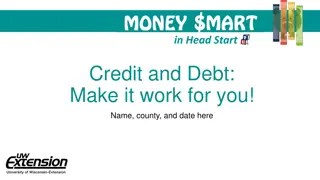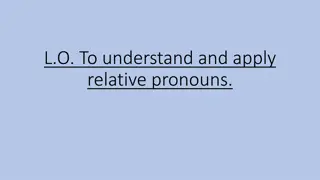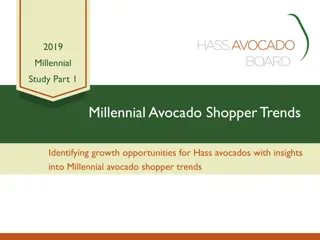Association Between Friendship-Relative Network and Credit Borrowings in Indian Households
This study by Dr. Pallabi Chakraborty explores the impact of friendship-relative networks on borrowing from market lenders in Indian households. It examines the role of social connections in accessing formal and informal credit, and how these networks influence borrowing choices. The study aims to uncover the factors that affect these associations and sheds light on the dynamics between non-market and market lenders in India.
Download Presentation

Please find below an Image/Link to download the presentation.
The content on the website is provided AS IS for your information and personal use only. It may not be sold, licensed, or shared on other websites without obtaining consent from the author.If you encounter any issues during the download, it is possible that the publisher has removed the file from their server.
You are allowed to download the files provided on this website for personal or commercial use, subject to the condition that they are used lawfully. All files are the property of their respective owners.
The content on the website is provided AS IS for your information and personal use only. It may not be sold, licensed, or shared on other websites without obtaining consent from the author.
E N D
Presentation Transcript
Topic: Friendship-kinship Network And Access To Formal-informal Credit In India Abstract : We examine the association between the friendship-relative(FR) network and borrowings from market lenders in the context of Indian households. We explore various channels that may affect the observed associations, if any. Presented By PALLABI CHAKRABORTY Assistant Professor Tata Institute Of Social Science, Hyderabad, India
Indian Stata User Conference 2023 Dr. Pallabi Chakraborty School of Public Policy and Governance Tata Institute of Social Sciences, Hyderabad 30thNovember2023
Friendship-kinship network and access to formal-informal credit in India
Background and Motivation Households borrowing choices between formal and informal lenders have been widely discussed in the literature (Fafchamps & Gubert, 2007; Kinnan & Townsend, 2012; Karaivanov & Kessler, 2018; Muduli & Dash, 2019). Social connections facilitate credit access in developing countries (Fisman et al., 2017; Turvey & Kong, 2010; Zeller, 2006). An example of informal social network is friends and relatives network (FR network). source of financial information (Jiang et al., 2022; Okten & Osili, 2004;Y.Zhang et al., 2012) monitoring and enforcement mechanism (Sun et al., 2018; Okten & Osili, 2004;Y. Zhang et al., 2012) source of credit (Fafchamps & Gubert, 2007; Ferrara, 2003; Kinnan & Townsend, 2012; Lee & Persson, 2016).
These are non-market institutions (NMIs) (Arnott & Stiglitz, 1991) and coexist with market lenders (e.g., banks, MFIs, moneylenders). The nature of interaction between FR network and market credit is examined in terms of applicationchoices and approval decisions in case of banks, moneylenders and MFIs. We capture FR network by a dummy indicating the incidence of borrowing from this network (Muduli & Dash, 2019). FR network ={1, if a household has taken a loan from its friends and/or relatives; 0 otherwise}. Wecontribute to the broad literature on linkages between market and non-market insurance.
FR loan may satisfy HHs demand for credit either partially or completely. Complete :-ve coefficient of FR loan on P(application). Partial :+ve coefficient of FR loan on P(application). With a loan from FR network, a borrower may become eligible for a market loan (+ve). Availability of a second source may generate additional demand for credit (+ve). For lenders, FR network may signal creditworthiness of potential borrowers. May also serve monitoring roles (+ve coefficient)
I. Regression specification ?????????i = ?O+ ?1??????i+ ?2??+ ?s,i+ ?1i (1) (selection model) ??????????i = ?O+ ?1??????i+ ?2??+ ?s,i + ?2i, ?????????i = 1 (2) (outcome model) AdobeAcrobat Document II. Identification strategy Bank: idiosyncratic shock dummy Moneylender : idiosyncratic shock dummy, occupation type of the household (3 categories) MFI: idiosyncratic shock dummy III. Endogeneity of FR network ??????i = ?O+ ?1??????i+ ?2????????i+ ?3?????????????i+ ?4?i+ ?s,i+ ?i .(3)
NOTE: HHs may fall into any of the following three categories: a) apply to both market lender(s) and FR network simultaneously; b) apply to a market lender and then to FR network (sequential); c) apply to FR network and then to a market lender (sequential). Data: Second round of India Human Development Survey (2011-12). Sample size: 42,152 households (Stage 1) 23,699 applicants (Stage 2) List of variables AdobeAcrobat Document
AdobeAcrobat Document FINDINGS Bank Moneylender MFI Variables approval application approval application approval application any FR loan -0.6150*** (0.2030) 0.6851*** (0.1071) -0.2197 (0.1618) 0.6587*** (0.0708) 0.1899 (0.3038) 0.6939*** (0.1761) IVs Bank Moneylender MFI HH size 0.0416*** (0.0036) 0.0427*** (0.0041) 0.0409*** (0.0045) any marriage 0.2297*** (0.0259) 0.2338*** (0.0239) 0.2159*** (0.0213) publicmeetings 0.1785*** (0.0302) 0.1588*** (0.0279) 0.1645*** (0.0247) Covariates yes yes yes yes yes yes State fixed effects yes yes yes yes yes yes Robust standard errors in parentheses.*p < 0.10,**p < 0.05,***p < 0.01
Channels:The collateral channel The poor are quantity rationed (S. Boucher & Guirkinger, 2007; S. R. Boucher et al., 2008). Even the wealthy can be discouraged from borrowing when asymmetric information between transacting parties is high and due to lack of an insurance market, hence are risk rationed (S. Boucher & Guirkinger, 2007; S. R. Boucher et al., 2008; Cheng, 2007; Turvey & Kong, 2010). Can FR network alleviate these? ?????????i = ?O+ ?1??????i+ ????????? ????????+ ?3?i+ ?s,i+ ?1i (1) ??????????i= ?O+ ?1??????i+ ????????? ????????+ ?3?i+ ?s,i + ?2i, ?????????i= 1 (2) Small & above: own more than 2.47 acres of land Semi-medium & above: own more than 4.94 acres of land
Results Adobe Acrobat Document Bank Moneylender MFI Variables approval application approval application approval application -0.5982*** (0.2046) 0.6277** (0.1472) -0.2124 (0.1493) 0.5994*** (0.0727) 0.2413 (0.2844) 0.6294*** (0.1210) FR loan Small & above FR*small & above 0.1761** (0.0715) 0.4177** (0.0293) -0.1207** (0.0483) -0.0601 (0.0497) -0.0974 (0.0639) -0.0555 (0.0501) 0.1098 (0.0683) 0.1677*** (0.0440) 0.1525*** (0.0436) -0.0188 (0.1233) -0.0664 (0.0729) -0.2224** (0.0920) -0.4847** (0.2335) 0.6144*** (0.1241) -0.2040 (0.1421) 0.6247*** (0.0756) 0.1975 (0.2921) 0.6330*** (0.1162) FR loan Semimed & above FR*semimed & above 0.1286 (0.0781) 0.4184** (0.0248) -0.1232* (0.0676) -0.0377 (0.0365) -0.1360** (0.0571) -0.0688 (0.0583) 0.1612*** (0.0551) 0.1785*** (0.0485) 0.2187*** (0.0664) -0.1015 (0.1278) -0.1300 (0.0923) -0.1417 (0.1194)
Channels: The channel of political connections Does FR network substitute or complement political connections (Acemoglu, 2006; Banerjee & Munshi, 2004; Chatterjee & Pal, 2021; Tsai, 2004;Y. Zhang et al., 2012) ? FR loan*political network, where pol. network=1 if any one in HH joined political party, or any Panchayat member/official in the HH or close to it. FR network is complementary to political connections when it comes to getting a loan from bank. Adobe Acrobat Document
Channels: The channel of social expenditures Interpersonal lending and borrowing involves an element of reciprocity, which increases social expenditures of the households(Ferrara, 2003; Heyer, 1989; Zeller, 2006; Yuan & Xu, 2015; Shoji et al., 2012). Does FR network play any role? FR loan* log social expenditure incurred by the HH Adobe Acrobat Document FR network increases the likelihood of application to moneylender for households with a larger social spending, on average.
Conclusion FR network works towards facilitating the expansion of market credit. There is no evidence of crowding out, instead crowding in of market loans. Effect more evident in the application stage than in case of approval. What does the literature suggest? Is borrowing from FR network a preferred choice? Or is it a consequence of spill-over of demand from formal sector(Bell et al., 1997; Turvey & Kong, 2010; Karaivanov & Kessler, 2018)? Do they crowd out other lenders? Turvey and Kong (2010) suggest that in China trust among borrowers and their FR network is so high that it has not only crowded out rural credit cooperatives, but also registered micro-finance institutions.























